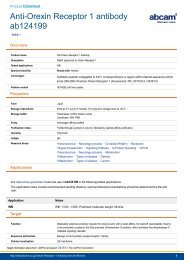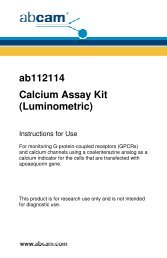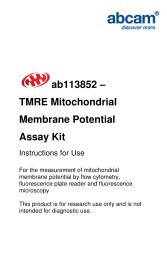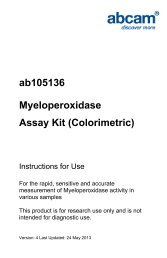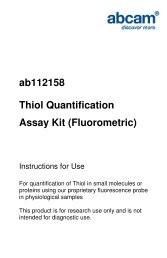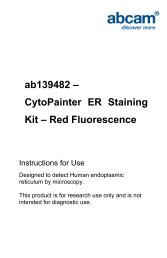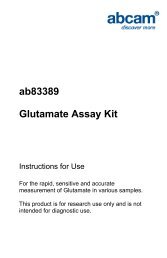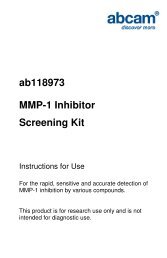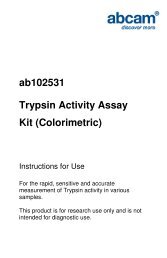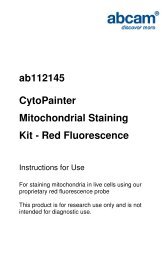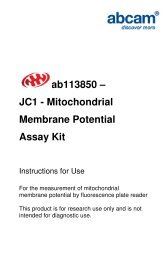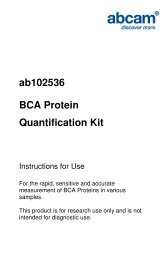Drosophila whole mount immunohistochemistry protocol - Abcam
Drosophila whole mount immunohistochemistry protocol - Abcam
Drosophila whole mount immunohistochemistry protocol - Abcam
- No tags were found...
Create successful ePaper yourself
Turn your PDF publications into a flip-book with our unique Google optimized e-Paper software.
Antibody staining of <strong>whole</strong> <strong>mount</strong> <strong>Drosophila</strong> embryosBy Dr. Torsten Bossing, Wellcome Trust / CRUK Gurdon Institute, U.K.Protocol for antibody staining of <strong>whole</strong> <strong>mount</strong> <strong>Drosophila</strong> embryos using GFP antibody (ab290)IF image produced using Bossing's <strong>whole</strong> <strong>mount</strong> <strong>protocol</strong>Embryos were injected with aplasmid carrying a fusion of theActin coding region to GFP(<strong>Abcam</strong>) ab290(Bossing et al., 2002).Expression is activated by theGAL4/ UAS system (Brand andPerrimon, 1993).Image courtesy of Dr. TBossing.Protocol:1. Prepare fixation mix in 1.5 ml cap: 400 µl PBS, 100 µl 40% formaldehyde and 500 µl n-heptane. For thedetection of some extracellular antigens it helps to add 0.02% SDS or to fix the embryos in 500 µl picric acid / 500µl n-heptane. Vortex the fixation mix at highest speed for 1 min.2. Remove yeast and dechorionate embryos by covering the apple-juice plate with 100% bleach for 2min; slightrotations of the apple-juice plate will bring the dechorionated embryos to the surface.3. During bleaching: close the narrow opening of a funnel with a nylon-mesh (diameter of holes: 40 µm), attachmesh by wrapping a rubber band around the funnel.4. Wash embryos into the funnel by squirting deionized water over the plate, especially along the edges of theplate; wash embryos in funnel by squirting water along the funnel three times.5. Remove rubber band and mesh; pick up the embryos with a very fine paint brush; dechorionated embryos willadhere to the brush; dip brush with embryos into the fixation mix and whisk the brush.6. With the cap lying on its side fix embryos for 15 min on a shaker with gentle rotation.7. During fixation: heat the tip of a glass Pasteur pipette over a Bunsen burner; aim the flame at the middle of thetip and hold the end of the tip with two fingers (glass is a bad heat conductor therefore your fingers are safe); whenthe middle glows red remove the tip from the flame and immediately pull; break away the long drawn out and verythin part from the tip. As an alternative to the glass pipette it is possible to use a 1 ml Gilson pipette.8. To stop fixation remove about 80% of the lower phase of the fixation mix with the pipette; fill up the cap with 1 mlof methanol and vortex on highest speed for about 1 min. This procedure will remove the extraembryonicmembrane.www.abcam.com/technical
9. 2 min after vortexing the majority of the embryos will be at the bottom of the cap. If not all embryos sink to thebottom of the cap, remove as much of the liquid as possible and refill the cap with methanol. Do not vortex again.After most of the embryos are at the bottom of the cap, remove all liquid and wash embryos three times withmethanol.10. Rehydrate the embryos with three washes in PBT (PBS with 0.3% Triton added); incubate in 20% newborn calfserum / PBT on shaker for at least 10 min. Note that Triton only slowly dissolves in PBS i.e. set up the solutionabout 20 min in advance. PBT can be kept at room temperature indefinitely. Calf serum should be stored in thefridge and 0.02% sodium azide should be added.11. Add primary antibody diluted in 10% NCS / PBT and 0.02% sodium azide; most primary antibodies can be usedat least three times i.e. store the primary after the first incubation at 4 o C for further stainings; diluted 1:1000(<strong>Abcam</strong>) ab290 can be re-used five times.12. Depending on the quality of the primary antibody, incubations can last from 2 hr at room temperature (highaffinity antibodies) to overnight at 4 o C (low affinity antibodies). Overnight incubation at 4 o C aides the perfusion ofthe antibody. For (<strong>Abcam</strong>) ab290 2h at room temperature are sufficient.13. Wash procedure: three rinses with PBT, 10min incubation with 30% NCS / PBT, three rinses with PBT, 10minincubation with 30% NCS / PBT, three rinses with PBT.14. Add secondary antibody diluted in 10% NCS / PBT for 2 hr at room temperature, lay cap on its side on a gentlymoving shaker.15. Repeat step 13.16. Non-fluorescent detection: use Diaminobenzidine assay (normal signal) or Alkaline Phosphatase assay (weaksignals); develop Alkaline phosphatase signal in the dark and take an aliquot of embryos out of the cap with a 1mlGilson pipette to follow the staining; postfix embryos with 4% formaldehyde / PBT for 10 min to stabilize AlkalinePhosphatase signal.Enhancement of very weak signals: use Vectastain ABC Elite Kit, or TSA KitFluorescent detection: use secondary antibodies coupled to Alexa488, Alexa568 or Cy517. Incubate embryos in 50% glycerol / PBS until they sink to the bottom of the cap (about 10 min); replace the50% glycerol l /PBS with 70% glycerol / PBS wait again until embryos are at the bottom of the cap (about 1hr);replace 70% glycerol/ PBS with 90% glycerol / PBS and allow embryos to sink to the bottom of the cap. Embryoscan be stored in 90% glycerol / PBS at 4 o C for at least three years. There is no need for any light protection forfluorescent stainings.www.abcam.com/technical



